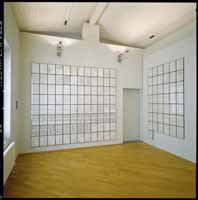

I blasted through The Panza Collection and had pretty low expectations about what I was going to see. I knew there would be a Weiner or two, which always make me smile, but Kosuth is such a downer for me. In one of the wall texts I read a quote from Panza that said (I'm paraphrasing) with Conceptual Art philosophy finally had a visual representation. The problem with that is that it is the same Deconstructionist/Post-Structuralist philosophy over an over again. I really like Foucault, Blanchot, Lacan, Derrida, but come on! Okay so I am mainly harping on Kosuth. His is a work of "pratitude" if I may.
However the Panza experience was rewarding in many ways. True you might have had to stumble through you Art Theory classes to "get it", but there is a lot of content beyond the super literal philosophical readings. Much of the work satisfies a much broader context having to do with real life. That isn't something I would normally think about "Minimo-conceptualism." (I made that up) Hamish Fulton is but one example.
As I said, Weiner makes me smile because his work is perfectly Reduced. Pun intended. The other one, A rubber ball thrown on the sea, Cat. No. 146, 1970 I didn't get.
Hanne Darboven's 00-99=No1-2K-20K, 1969–70 and 27K-No8-No26, 1968–69 are wonderful in their application to language and fake systems, as well as in the graphic beauty of writing and diagrams. I used to, as a young geometer and algebra student, love the way the pages in my class notebooks looked. We would be forced to copy theorems, proofs and diagrams for an hour and I couldn't get enough. Aesthetics of math are fine, but once the reasoning of math is required I start to really blow it. That's a personal problem, so let's move on.
The most visually active work a la Turrell, was Doug Wheeler's Eindhoven, Environmental Light Installation, 1969. There is a mostly closed off gallery with this light ringing the perimeter of the back wall.
TIP: if you walk half the distance toward the light rectangle your peripheral vision is blocked by hazy blue light, which is awesome. It is the only time which it is just the effect of the work and your visual ability. If you get too close you see the neon tubes, too far and you see peoples' footprints and the total gallery space. Not awesome.
Another surprising work is Jan Dibbet's Jan Dibbets The Shortest Day of 1970 Photographed in My House Every 6 Minutes from Sunrise til Sunset, 1970. Through the sequence of photos you begin to notice different aspects of the environment reveal them selves over the course of shooting. It is very subtle but very rewarding.
Here is a link to the Checklist pdf, so I don't have to go through and hyperlink everything. I do have other stuff to do you know.
No comments:
Post a Comment